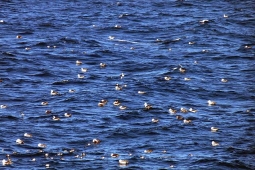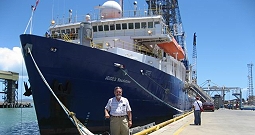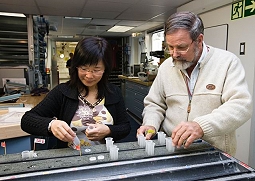The bell tolls for the IPCC
[This is an expanded version of a brief essay published by The Drum]
It is a fine day, and God is obviously in his heaven.
I am standing on the helicopter deck of the famous science-drilling ship JOIDES Resolution. The snow-capped mountains of South Island, New Zealand, glisten gently along the far western horizon. A majestic rolling, royal blue swell strokes the sides of the ship. Its origins lie deep in the Southern Ocean, and its crests are ruffled into a maze of small waves, ripples and white patches of gently breaking foam by today’s northeasterly breeze.
I feel like Admiral Jellicoe reviewing the Home Fleet on the Solent in 1907, for behind the ship bobs a flotilla of a thousand or more albatrosses, mollymawks and cape pigeons, most preening, courting, sleeping with heads tucked in or just lollygagging around in the sunshine, some few doing aerial acrobatics apparently for no other reason than the sheer zest of living; when and how this great mass of birds feeds remains mysterious to me, but generally their life out here seems to be, what else, a breeze. And that the stern flotilla is of seabirds rather than warships is particularly appropriate, for JR, as she is affectionately known to those aboard, is a research flagship for the environmental and earth sciences rather than for any navy.
It is a privilege and a pleasure to be here. The group of 50 scientists and technicians on board are drawn from the best in the world, and from the many country members of the International Drilling Program (IODP). They are supremely good at their highly skilled jobs, as are the ship’s and drilling crews. For a research proposal to be allocated a drilling leg on JR – which lasts 2 months and costs about US $15 million to conduct – the science involved has to survive the most rigorous international peer-review, at which stage many drilling proposals fail.
The drilling leg in which I am participating has been fostered by a group of scientists who are vitally interested in the topic of ancient sea-level and climate changes. Faintly, for it is far away, I remember that these issues are the focus of the current international climate jamboree in Copenhagen.
I grimace at the thought, because the study of climate change, under the aegis of “dangerous global warming caused by human carbon dioxide emissions”, has long since been captured by the small group of well connected, well networked and well funded atmospheric scientists and computer modellers who advise the Intergovernmental Panel on Climate Change (IPCC), and whose nearly every utterance confirms their ignorance of the true course of climate history and change on our planet – a topic that is the domain of geologists, not meteorologists and computer jockeys.
All of which may seem a long prologue to the main Act of this article, which started out to be the relationship between Climategate and the IPCC’s COP-15 climate conference in Copenhagen.
These two events have been described in literally thousands of media and web articles over the last few months, and especially weeks, and there is little original that I can add. But for readers who may have been otherwise engaged, here’s a quick summary. “Climategate” refers to the recent leaking of a copious file of emails, technical papers and computer codes from the Climate Research Unit at the University of East Anglia, which is the research group that provides the IPCC with its iconic global temperature curve since 1860.
The main Act can now be stated in two brief paragraphs.
The Climategate files have demonstrated the scientific malfeasance of an influential and internationally well networked segment of the climate research community. A small group of scientists and computer modellers – with the aid of an enormous supporting cast of environmental activists and organisations, self-interested business groups, and crusading journalists – have managed to turn the global warming issue (which in 1990 was an entirely sensible matter to have raised) into the scientific scam of the century, if not the biggest ever.
The IPCC is the official UN body that has presided over this fiasco. It is an organisation that was specifically set up to provide advice to national governments (including Australia’s) for their use in setting climate policy. The IPCC’s incompetence is manifest in its failure to detect the corrupt science that has for so long permeated the activities of the international jetsetters of the climate science power group. The organisation should be closed down (without tears), and the Copenhagen COP-15 meeting would be a good place to start this process happening.
But back now on the helicopter deck, a second Act is forming in my mind.
As I scan the horizon idly, it comes to mind that almost 2 km of drill core and exciting preliminary research results have passed before my eyes in the last 3 weeks, yet I have no research funding with which to work up the scientific results of this cruise. For the wise referees and adjudicatory panel of the Australian Research Council three years in a row rejected my application for funding.
However, as researchers go, I am an old fox, and more than content that my enthusiastic younger colleagues should be the ones to work up the main results from this cruise. My concern with the science funding system, then, is not a personally bruised ego, but rather for them – the scientists in the early or middle stages of their careers, all of whom understand only too well (not least from the example made of me and many other “dissident” climate scientists) that to get funding for their research they have to conform to the scientific political correctnesses of the day. This is neither personally satisfying and nor, most certainly, does it stimulate the sort of unconventional creativity and lateral thinking on which many scientific breakthroughs are based.
In 1957, the pivotal Murray Committee investigation into Australian universities commented that the greatest advances in knowledge came “because free enquirers have been pursuing their own ideas and insights, devotedly and with great persistence, in pursuit of enlightenment for its own sake”, adding that the university staff must be “guardians of intellectual standards and intellectual integrity in the community”, so as to be “proof against the waves of emotion and prejudice which make the ordinary man, and public opinion”.
Such old-fashioned ideals will doubtless seem naïve to the serried ranks of our modern Deans, Pro-Vice-Chancellors, Deputy Vice-Chancellors and University Presidents, but I’ll bet that right now the Vice-Chancellor of the University of East Anglia is wishing he had applied them better himself.
It’s not just prestigious science institutions but also the world’s formerly most excellent scientific publications that have had their reputations traduced by the Climategate scam. For instance, since the 1990s, Science, Nature and New Scientist have become renowned as propaganda outlets for the climate cognoscenti and their allies. For years now, these magazines have been providing pompous editorial claptrap to go along with their flawed environmental research papers, like the following gem from Nature in 2002: “The public expects scientists ….. to have high standards. …. Trust in science …. (can) be diminished by people who exploit scientific uncertainty for political ends, such as casting doubt on the evidence for global warming or evolution. A few ‘sceptics’ appearing on TV can confuse a public that expects monolithic truth from science”.
That the global warming scare should turn out to be precisely the scam that climate rationalists (aka Nature’s sceptics) have been banging on about for years is shocking enough; many future PhD theses and books will undoubtedly be written about it. Yet it is but the tip of the iceberg so far as the public prostitution of science is concerned. Climategate being currently in full swing, the obvious question is when (not if) the parallel Reefgate, Murraygate and Fishgate scandals will erupt in Australia?
All Australians should contemplate deeply the questions that are raised by the global warming scandal, including the systemic corruption of science and the dereliction of duty by media news organisations that it reveals. Key questions include the following.
Why has our formerly excellent national science agency, the CSIRO, been allowed to become a consultancy arm for the government?
Why, amongst other shameless activities, has CSIRO been allowed to go around selling region-customized reports that are implied to provide climate predictions, but which in fact contain projections that are statistically no better than flipping a coin?
(CSIRO’s back is protected, of course, by the doubtless expensive lawyers who have insisted that the following disclaimer be inserted in all such reports: “This report relates to climate change scenarios based on computer modelling. Models involve simplifications of the real processes that are not fully understood. Accordingly, no responsibility will be accepted by CSIRO or the QLD government for the accuracy of forecasts or predictions inferred from this report or for any person’s interpretations, deductions, conclusions or actions in reliance on this report”. Would you buy a used car from these people?).
Why has the Australian Research Council been required to apply “national science priorities” as if any scientist, however distinguished, let alone a bureaucrat or politician, has the wisdom to discriminate between useful and “useless” research?
As recognized in the operation of our national Institute of Sport, there is really only one relevant priority for funding research, and that is that the research be demonstrably of world-standard excellence; which was in fact the leit motif of ARC’s predecessor agency, the former (itself excellent) Australian Research Grants Committee.
In the early 1980s it all seemed so simple. “We shouldn’t be wasting money on research into Greek pots, Minister”, said the imposing assembly of businessmen and bureaucrats, “rather, we should be allocating taxpayers’ money only to research that is useful”.
Leaving aside that this confuses a vital distinction between the important activity of applied research and development and what is sometimes termed blue-skies research, thus begins the slippery path to the systemic science disaster that now confronts us. After the relentless application of policies like these for more than two decades, inevitably scientists who were world class at research have turned into scientists who are instead world class at identifying environmental scares, for that is the tree from which the money hangs.
Though it is deeply unfashionable to say so, providing public money for scientific research is justifiable mainly for the knowledge that it provides, quite irrespective of any “useful” discoveries that may result. For example, at first blush it is not particularly useful to know about the dinosaurs, but our society (not to mention Michael Crichton and Steven Spielberg) would be much the poorer if we didn’t.
The history of science is replete with examples of serendipity in research, examples of which include the discovery of x-rays, penicillin and the transistor. Thereby, it turns out that spending research dollars is very similar to spending advertising dollars. Every experienced businessman knows that much of the money spent on advertising is wasted; large amounts of money could be saved if only one knew in advance which particular piece of advertising will actually work.
And thus it is for science. Support one hundred research proposals, and probably every single one will produce results that are of interest to some segment of our community. One or two of the projects will result also in “useful” discoveries, but I’ve never met anybody, and nor do I expect to, who could tell me in advance which two.
Behind the corrupted science of Climategate and the fall of the IPCC, then, lie not one but two things. The first, which this article has ended up commenting on, is the degradation, mainly by political interference, of the conditions and practices of researchers who depend mainly on government funding – which is nearly all of us. The second, which requires a separate article by a sociologist or historian to explain it, is the power and financial clout of the modern, ecoevangelistic Green movement, egged on by crusading media reporters and editors. The world has probably never before seen a propaganda and political machine that is as well oiled, well funded and well organized as this modern army of apocalyptics and their media flag-wavers.
Influenced by the media barrage, voters who respond to the siren song of the Greens imperil both our standard of living and, ironically, the state of our natural environment. Because every dollar that is spent on a false environmental issue such as dangerous human-caused global warming is a dollar that is not available to be spent on a real environmental or social problem.
“Think hard before you vote” and “don’t believe everything you read or hear on the news” may be truisms. But in the today’s charged media and political environment, they are also the most practical advice that can be given to those who are genuinely concerned to help conserve our natural environment.
Bob Carter is a geologist from James Cook University, Queensland. He was not paid by an energy company to write this article.
 Sign In
Sign In 0 Items (
0 Items ( Search
Search









The wonder of the Internet (and Quadrant’s internal links) brought me to this fabulous article by Bob.